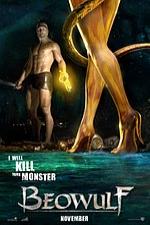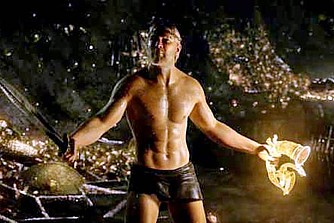
"Knight Thoughts" -- exclusive web content
Performance Capture comes of age with a new screen adaptation of the classic tale, a sensational, homoerotic video game writ
large
large
3D Indeedy:
Beowulf
11-16-07 "Knight Thoughts" web exclusive review
By Richard Knight, Jr.
Beowulf
11-16-07 "Knight Thoughts" web exclusive review
By Richard Knight, Jr.
The gigantic, epic sprawl of 3D is perfectly suited for the oldest of action stories – the classic tale of Beowulf, which has been
cleverly adapted for modern movie audiences by director Robert Zemeckis. And utilizing the technique called “performance capture”
– a computerized blending of the actor’s movements and voices with digitized effects – that Zemeckis first introduced (less
successfully) in 2004 with The Polar Express proves a stroke of inspiration. Welded to the gleeful effects made possible by the
curved, looming I-Max screen, here at last is the enormous video game/cartoon masquerading as a movie that adult male children
have been waiting for. It’s a sight to behold, this Beowulf – the antitheses of the epic but beautifully written poem we all had to slog
through in junior high school – and with the voices of Ray Winstone, Anthony Hopkins, Angelina Jolie, Robin Wright Penn, John
Malkovich, Crispin Glover, and Brendan Gleeson it's a pleasure to listen to as well.
Set in Denmark in 507 the story centers on the stunning 6 foot 6 piece of eye candy Viking hero Beowulf (Winstone) who arrives at
the splendid mead hall of King Hrothgar (Hopkins) after the deformed giant Grendel (Glover) has interrupted a very loud, lusty
bacchanal and laid waste to many of the king’s subjects. Beowulf, not acquainted with fear, agrees to rid the kingdom of Grendel
and further decides that in order to do so, he must meet the monster on his own terms – weaponless and without a stitch of
clothing. At this point, without hesitation, Beowulf strips down to his twig and berries and stretches out to take a nap in the buff.
Throughout the ensuing battle with the forlorn Grendel (a giant sized variation of the treacherous but mournful Gollum) which follows
shortly thereafter Beowulf’s manhood is coyly covered (in the Austin Powers mode) but nothing can cover up the homoerotic subtext
that has jumped front and center. From that point on, Beowulf, obviously a confirmed naturalist, is as quick to remove pieces of his
clothing as he is to jump into battle and while it made the straight boys in the audience titter nervously, we gay men lapped it up.
Beowulf's delicious enemy is Grendel’s mother, sexily imagined (down to the cloven hoofed stripper heels) in the person of the
curvaceous Jolie. She and Glover whisper to each other in a tongue thick with vowels (it turns out to be Old English) and when
Grendel dies Jolie vows revenge (and boy does she get it). Jolie again sports an accent and really seems to purr as she glides out
of the water to seduce and tame the warrior who has come to kill her but instead succumbs to her charms. The result will be another
monstrous son for mama Jolie (a son who will grow up to be a dragon and rain down havoc on Beowulf and his kingdom).
The performance capture technique has been perfected since its debut in The Polar Express allowing the filmmakers to imagine
whatever physical perfection (or imperfections) they wish for their characters. The problem the technique had in capturing the
mouths and vocal gestures of humans in Polar Express has been advanced to the point that a performance of two eerie and beautiful
songs sung by Wright Penn as first Hopkins’ queen and then Beowulf’s is tremendously moving. Those songs and the rest of the
score by Alan Silvestri are perfectly welded to Zemeckis’ images and Silvestri has written epic but melodic music that greatly helps
the action sequences which are intricately realized.
I’m not sure if this Beowulf, which adds a bit of complexity to the straight ahead story, would pass muster in Miss Eggelston’s 8th
grade English class, but I was transported. And it’s still a very simple, pleasurable tale in the action classic mode like “Robin Hood”
or one of the best of Greek mythology. Conversely, I can’t say for sure that the film will hold up in a plain old 2D version but
Hollywood – both sides of the line – will surely take note. Here is a process that can alter the bodies and faces of actors to the point
of physical zenith, allow directors and writers to realize any scenario, and utilize complex technologies to make it thrillingly happen.
Now one can’t exactly imagine Who’s Afraid of Virginia Woolf? or Private Lives benefiting from performance capture but for future action
film producers this will suddenly seem not just a viable alternative but a tantalizing one.
cleverly adapted for modern movie audiences by director Robert Zemeckis. And utilizing the technique called “performance capture”
– a computerized blending of the actor’s movements and voices with digitized effects – that Zemeckis first introduced (less
successfully) in 2004 with The Polar Express proves a stroke of inspiration. Welded to the gleeful effects made possible by the
curved, looming I-Max screen, here at last is the enormous video game/cartoon masquerading as a movie that adult male children
have been waiting for. It’s a sight to behold, this Beowulf – the antitheses of the epic but beautifully written poem we all had to slog
through in junior high school – and with the voices of Ray Winstone, Anthony Hopkins, Angelina Jolie, Robin Wright Penn, John
Malkovich, Crispin Glover, and Brendan Gleeson it's a pleasure to listen to as well.
Set in Denmark in 507 the story centers on the stunning 6 foot 6 piece of eye candy Viking hero Beowulf (Winstone) who arrives at
the splendid mead hall of King Hrothgar (Hopkins) after the deformed giant Grendel (Glover) has interrupted a very loud, lusty
bacchanal and laid waste to many of the king’s subjects. Beowulf, not acquainted with fear, agrees to rid the kingdom of Grendel
and further decides that in order to do so, he must meet the monster on his own terms – weaponless and without a stitch of
clothing. At this point, without hesitation, Beowulf strips down to his twig and berries and stretches out to take a nap in the buff.
Throughout the ensuing battle with the forlorn Grendel (a giant sized variation of the treacherous but mournful Gollum) which follows
shortly thereafter Beowulf’s manhood is coyly covered (in the Austin Powers mode) but nothing can cover up the homoerotic subtext
that has jumped front and center. From that point on, Beowulf, obviously a confirmed naturalist, is as quick to remove pieces of his
clothing as he is to jump into battle and while it made the straight boys in the audience titter nervously, we gay men lapped it up.
Beowulf's delicious enemy is Grendel’s mother, sexily imagined (down to the cloven hoofed stripper heels) in the person of the
curvaceous Jolie. She and Glover whisper to each other in a tongue thick with vowels (it turns out to be Old English) and when
Grendel dies Jolie vows revenge (and boy does she get it). Jolie again sports an accent and really seems to purr as she glides out
of the water to seduce and tame the warrior who has come to kill her but instead succumbs to her charms. The result will be another
monstrous son for mama Jolie (a son who will grow up to be a dragon and rain down havoc on Beowulf and his kingdom).
The performance capture technique has been perfected since its debut in The Polar Express allowing the filmmakers to imagine
whatever physical perfection (or imperfections) they wish for their characters. The problem the technique had in capturing the
mouths and vocal gestures of humans in Polar Express has been advanced to the point that a performance of two eerie and beautiful
songs sung by Wright Penn as first Hopkins’ queen and then Beowulf’s is tremendously moving. Those songs and the rest of the
score by Alan Silvestri are perfectly welded to Zemeckis’ images and Silvestri has written epic but melodic music that greatly helps
the action sequences which are intricately realized.
I’m not sure if this Beowulf, which adds a bit of complexity to the straight ahead story, would pass muster in Miss Eggelston’s 8th
grade English class, but I was transported. And it’s still a very simple, pleasurable tale in the action classic mode like “Robin Hood”
or one of the best of Greek mythology. Conversely, I can’t say for sure that the film will hold up in a plain old 2D version but
Hollywood – both sides of the line – will surely take note. Here is a process that can alter the bodies and faces of actors to the point
of physical zenith, allow directors and writers to realize any scenario, and utilize complex technologies to make it thrillingly happen.
Now one can’t exactly imagine Who’s Afraid of Virginia Woolf? or Private Lives benefiting from performance capture but for future action
film producers this will suddenly seem not just a viable alternative but a tantalizing one.


